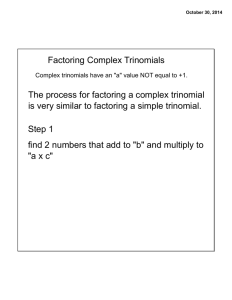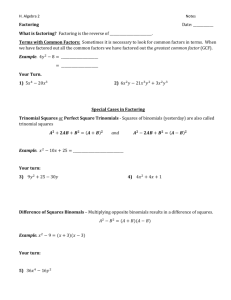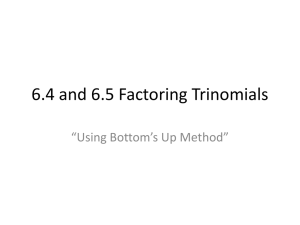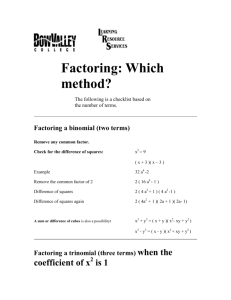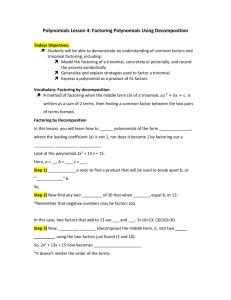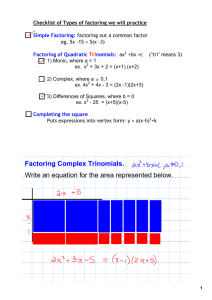Document
advertisement
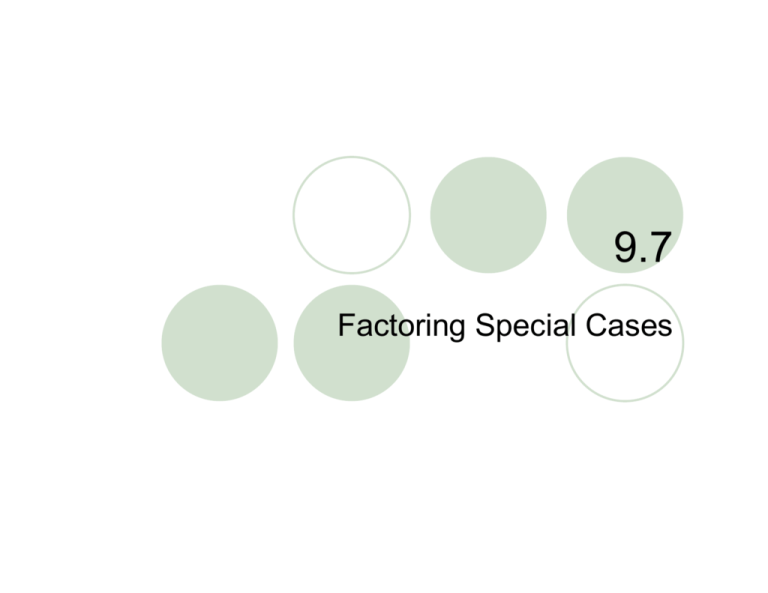
9.7 Factoring Special Cases 9.7 – Factoring Special Cases Goals / “I can…” Factor perfect – square trinomials Factor the difference of squares 9.7 – Factoring Special Cases First of all, what do these numbers have in common? 4 9 16 81 64 25 49 144 121 225 9.7 – Factoring Special Cases Recall: 2 2 (x + 2) = x + 4x + 4 2 2 (x – 2) = x – 4x + 4 These are called perfect square trinomials. Factoring: Perfect Square Trinomials The first criteria of a Perfect Square Trinomial is that it must have three terms. Using FOIL we find the product of two binomials. (a + b)(a + b) = a + ab + ab + b 2 2 = a + 2ab + b 2 2 Rewrite the perfect square trinomial as a binomial squared. So when you recognize this… a + 2ab + b = (a + b)(a + b) 2 = ( a + b) 2 2 …you can write this. Recognizing a Perfect Square Trinomial x + 10 x + 25 2 First term must be a perfect square. (x)(x) = x2 Last term must be a perfect square. (5)(5) = 25 Middle term must be twice the product of the square root coefficient of the first and last term. (2)(5)(1) = 10 What if it is a Perfect Square Trinomial x + 10 x + 25 2 If you have a perfect Square Trinomial it is easy to factor: Take the square root of the first term. Take the square root of the last term. Use the sign of the middle term, put in parenthesis and square the result. 2 2 x + 10 x + 25 = ( x + 5) Recognizing a Perfect Square Trinomial m + 8m + 16 = (m + 4) 2 2 First term must be a perfect square. (m)(m) = m2 Last term must be a perfect square. (4)(4) = 16 Middle term must be twice the product of the square root coefficient of the first and last term. (2)(4)(1) = 8 Recognizing a Perfect Square Trinomial p − 18 p + 81 = ( p − 9) 2 2 First term must be a perfect square. (p)(p) = p2 Last term must be a perfect square. (9)(9) = 81 Signs must match! Middle term must be twice the product of the coefficient of the first and last term. (2)(9)(1) = 18p Recognizing a Perfect Square Trinomial 121 p + 110 p + 100 Not a Perfect 2 Square First term must be a perfect square. (11p)(11p) = 121p2Trinomial! Last term must be a perfect square. (10)(10) = 100 Middle term must be twice the product of the first and last term. (2)(10)(11p) = 220p Perfect Square Trinomial Y/N Yes (r − 4 ) r − 8r + 16 2 2 Yes (7 p − 2 ) 49 p − 28 p + 4 2 49 s − 42 st + 36t 2 2 4m + 4mn + n 2 d + 50d + 225 2 2 2 No Yes (2m + n ) 2 No 9.7 – Factoring Special Cases 2 (x + 2)(x – 2) = x – 4 This is called the difference of squares What characteristics to both have in common? Different? Factoring Special Cases: Difference of Squares Difference of Squares a2 – b2 = (a + b)(a - b) Factoring Special Cases: Difference of Squares A binomial that is created by subtracting two perfect squares. Ex1: x2 – 4 Ex2: x2 – 625 Ex3: 4x2 – 25 Ex4: 16x2 - 81 What is true about the factored form of each of these binomials? Factoring Special Cases: Difference of Squares Factor each of the following completely: 1) x2 – 100 2) x4 – 16 3) 100x2 – 400 4) 3x2 - 75 5) 225x2 – 121y2 #2 isn’t quadratic and #5 isn’t a polynomial, but you can still factor them! 9.7 – Factoring Special Cases Using these, we can look to factor polynomials. 2 4t + 36t + 81 - Notice that the first and last terms are perfect squares. It has 3 terms, so it is a perfect square trinomial. 9.7 – Factoring Special Cases 2 9v – 16 - Notice that the first and last terms are perfect squares, but it has 2 terms, so it is the difference of squares. 9.7 – Factoring Special Cases REMEMBER, sometimes we need to factor a GCF first 3m 3 – 12m I can’t factor an m3, but I can factor a 3m 2 3m(m – 4) 3m(m – 2)(m + 2) Now I can factor.

